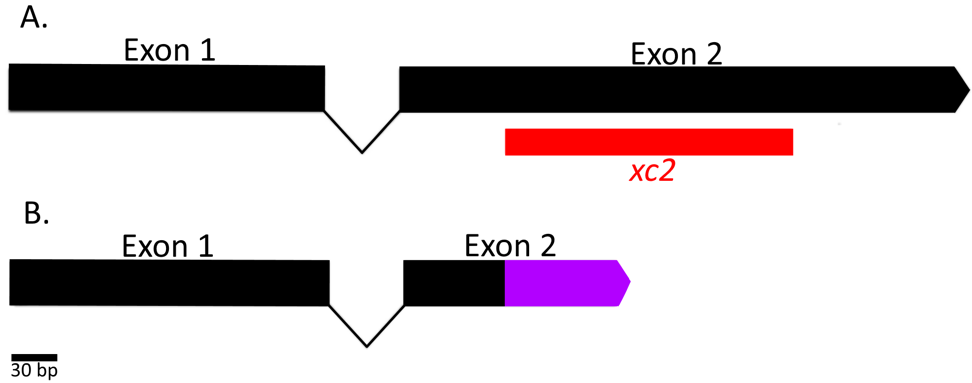Description
We created a new mutant allele, named xc2, of the gene spch-3 (T27A3.4). spch-3 encodes one of three C. elegans small, highly basic proteins that resemble invertebrate protamines and associate with sperm meiotic chromosomes (Chu et al., 2006). The alleles were isolated from gene mutations generated by Non-Homologous End Joining (NHEJ) mediated repair of Cas9-generated breaks (Dickinson et al., 2013; Ran et al., 2013). The alleles were discovered using PCR with the following primers 5’- CCCTCGTCTTCTCTACTAGA -3’ and 5’- CATAGCTTCACAGGGAGAAG -3’. Next Generation Sequencing let us identify 30 bp flanking sequences of the xc2 allele as GTCCGTCAACCCGCCGTTCGTCGTCTCGTC – [191 bp deletion] – TCTCGTCATCGCTCATCTTCGAAGGCTCGT. Wildtype spch-3 has 2 exons. The xc2 mutation is located in the second exon (Fig. 1A). In the mutant, while the first 97 amino acids of the mutant protein remain wildtype, they are followed by the deletion causing a frameshift mutation that adds 25 mutant amino acids (LSSSLIFEGSWTSCVDCKEDSCQKT) before the first resulting stop codon (Fig. 1B). Therefore, out of the 203 amino acids in the wildtype SPCH-3 protein, only the first 97 remain in the xc2 allele. Although the additional 25 amino acids may have an effect that is yet to be determined, the mutation in the second exon changes about 52% of the protein providing a unique opportunity to understand the function of SPCH-3 through mutant studies.
Reagents
Strains: XC111 spch-3(xc2)I (outcrossed 5x)
References
Funding
NSF RUI 1244517, NIH R15 HD068996
Reviewed By
Pei Yin ShihHistory
Received: May 1, 2018Accepted: May 1, 2018
Published: May 1, 2018
Copyright
© 2018 by the authors. This is an open-access article distributed under the terms of the Creative Commons Attribution 4.0 International (CC BY 4.0) License, which permits unrestricted use, distribution, and reproduction in any medium, provided the original author and source are credited.Citation
Munoz, NR; Byrd, DT; Chu, D (2018). New allele of C. elegans gene spch-3 (T27A3.4), called xc2. microPublication Biology. 10.17912/W2995W.Download: RIS BibTeX




